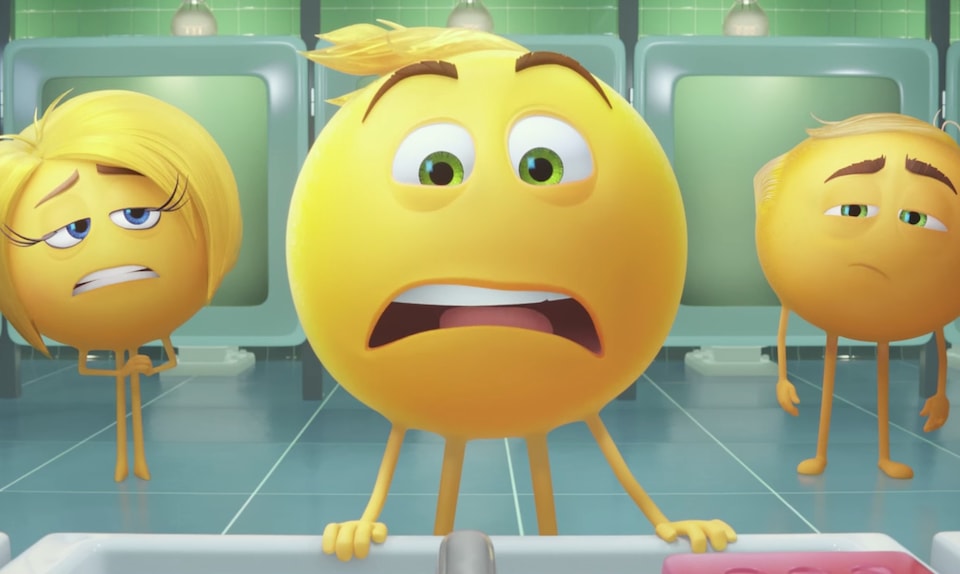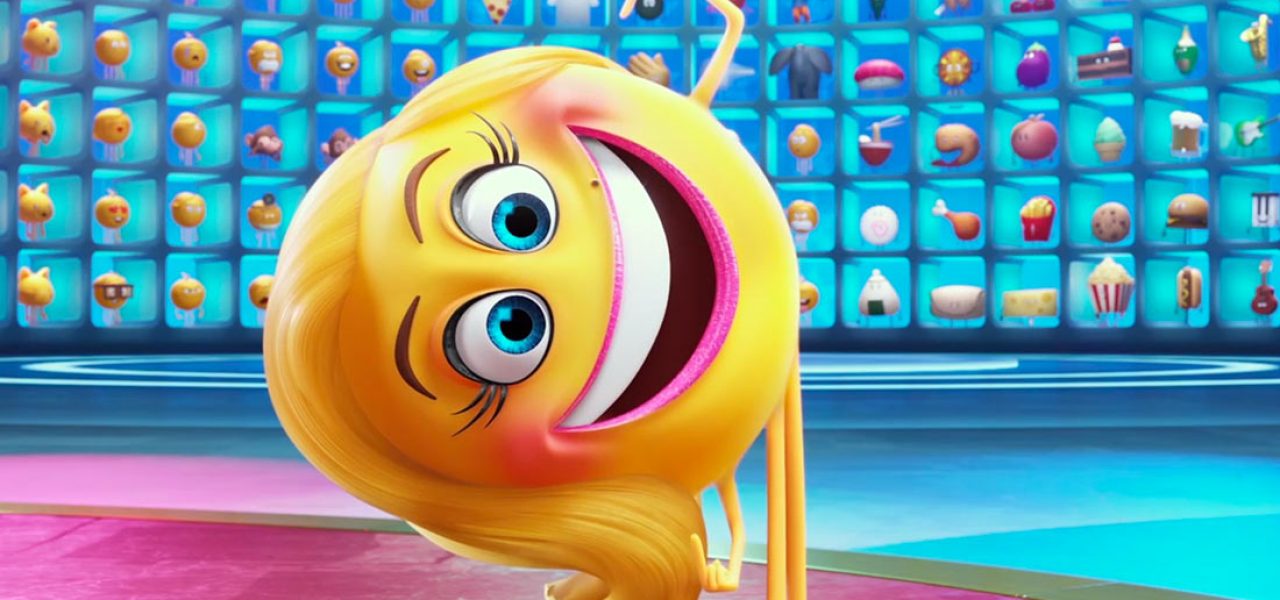4. The Animation

There are much worse and incompetent animated films (Norm of the North is the worst we can imagine for a theatrical experience and Foodfight is an abysmal nightmare). Despite the studio budget, The Emoji Movie may be the ugliest looking animated films in recent memory.
There’s zero creativity at display with The Emoji Movie especially by how little of the film was represented in the marketing. What’s shown is a movie made by producers who are more concerned with product placement and adding filler in each frame as a way to simply jangle keys to the youngest kids.
Not only the characters are wholly interesting, the character designs are unappealing on an animation standpoint that they give Illumination Entertainment’s library of characters a run for their money. Since the majority of characters are Emojis, their designs are overly simplistic, generic and broad. They lack depth all around (no pun intended) and how they are presented are by the surface with their inherent expressions of function.
At times, some of the characters are unpleasant to look at; purposefully for the plot, Smiler does serve as the main antagonist, given her ominous, ever-present grin, but as a marketing ploy, the character is a downright creepy image to sell to children.
Even Hi-5, an Emoji resembling a stubby hand with a face on legs is a rather bizarre image which is not supported well by James Corden’s voice performance. All of the characters are superficially bland and unappealing as opposed to the best characters shown in a modern Pixar film. Nobody is putting it lightly when the film rips off The Lego Movie, Wreck-It Ralph, and Inside Out altogether as the visual world-building will remind anyone to watch those films instead.
Gene, Jailbreak, the introduction to the society and the Wallpaper are straight out of The Lego Movie, The Candy Crush app, the Virtual Trash bin and the concept of a world within a young kid’s smartphone scream Inside-Out and lastly, the Emojis conforming to their inherent function is an idea taken from Wreck-It Ralph. The side characters are uninteresting that the Just Dance Dancer (Christina Aguilera) seems like a character would fit in an Audu Paden-cartoon from the early-2000s.
All of these elements are dominated by this glossy, oversaturated sweet palette and visual tone to make the youngest of the children’s audience drool on the screen that is unpleasant to look at.
Because of the film’s blatant display of product placement and generic, interchangeable design, The Emoji Movie is a culmination of every uninspired element woven into an animated film.
As mentioned before, it is not as over-animated or straight-to-DVD level of quality like the abominable Norm of the North, but with the budget and dedication these animators put into the film, it’s an ugly product green-lit by a monetary-driven decision for which the elephant in the room needs to be addressed.
5. SONY

Now, Sony Pictures Entertainment along with its subsidiary studios: Tri-Star, Columbia and Sony Pictures Animation have set of legacy, producing ground-breaking and innovative motion pictures that are still celebrated today.
SONY in its earliest roots of the 1920s was founded as Columbia Pictures, patenting filmmaking technology and producing feature-length films with Frank Capra carrying the name. Since then, Columbia produced one of the most iconic films (Dr. Strangelove, Kramer v. Kramer, Close Encounters of the Third and Ghostbusters), gaining Oscar-worthy recognition and setting a golden reputation for the company.
During the 1980s, the company faced corporate ownership, transitioning from Coca-Cola Company for a short-lived period until SONY Entertainment purchased Columbia in 1989, overseeing its studio and establishing new subsidiaries. From there, SONY continue to produce feature films for mainstream audiences, leading to popular franchises (Marvel’s Spiderman, the Men in Black films) and exemplary titles to kickstart their divisions (Cloudy with a Chance of Meatballs).
Once Amy Pascal took leadership as SONY’s Chairman, the quality in films began to flounder. Despite 2012 becoming the company’s most profitable year for films and their independent division, Sony Classic Pictures, continuing to produce Oscar-caliber films, SONY has gained a rotten track record of quality films under the present and eventual, post-Amy Pascal leadership.
The 2014 SONY cyber attack was a significant sign for the studio’s downward spiral when numerous emails and scripts were leaked by North Korean hackers, surrounding the controversy of the release of the raunchy political satire, The Interview.
The Hack led to the shift from Adam Sandler’s Happy Madison Company, the cancellation for The Amazing Spiderman cinematic universe and the failing political agenda pushed for Ghostbusters: Answer the Call.
In the case of The Emoji Movie, the film represents a continued business model that marred the name even before the unexpected cyber attack: producing films as corporate, pandering products without creative and artistic integrity. The film is no different from SONY’s other failures; it is a product of SONY’s committee of executives, examining focus group rates on what the current demographic is interested in.
As a result, the planned PopEye reboot held by Hotel Transylvania-creator Genndy Tartokovsky demonstrated in his fantastic short demo reel was scrapped because it is easy for SONY to profit on Emojis and social media to appeal to kids. SONY continues to make films to serve as adverts for their latest products to adhere to their shallow business standard of filmmaking.
Now every studio has their period of bad failures either from a filmmaker’s misleading vision or studio interference, but with The Emoji Movie, a call for overhaul for leadership and creativity can be pushed and with another needless reboot, Jumanji: Welcome to the Jungle, SONY’s future remains uncertain.
Conclusion

The Emoji Movie will definitely make the contender for the Worst Film of 2017 for apparent reasons: promoting the film as advertisements for cynical product placement and deriving the best animated films to make uninspired, pandering movies to sell to the lowest common denominator.
The main question has come to mind across many critics: Is The Emoji Movie reflect the death to cinema? No. The film is undoubtedly bad, but movies like these will happen even after a period of good films to drive their genre. In every good Star Wars and Marvel film, you’ll get another Transformers.
In every Big Sick, you’ll get your CHiPS. Finally, with every Pixar, Disney, and Lego film, you get your Illumination films and The Emoji Movie. This is the reality for films, but animated films designed for young audiences do not need to be pandering products with no substance as the final result.
A lot of the best family movies, namely, Pixar’s films are not afraid to tell fascinating stories with well-drawn, interesting characters and themes and fears that can challenge and teach children lessons on a universal level. This is mainly due to SONY’s lack of creative input and potential leadership to push the studio in providing good films for everyone to enjoy.
The world will never see Genndy Tartokovsky’s Popeye envisioned for the silver screen, but with the studio’s failures, SONY should grant him freedom to carry out his third Hotel Transylvania film and his future project to follow, Can You Imagine, no matter what the outcome turns out. By the end of 2017, Pixar’s Coco will soon hit theaters in the upcoming holiday season and sadly, with SONY’s tasteless animated reimagining of the Navitity Story, The Star, it’s safer to say: may God help us all.